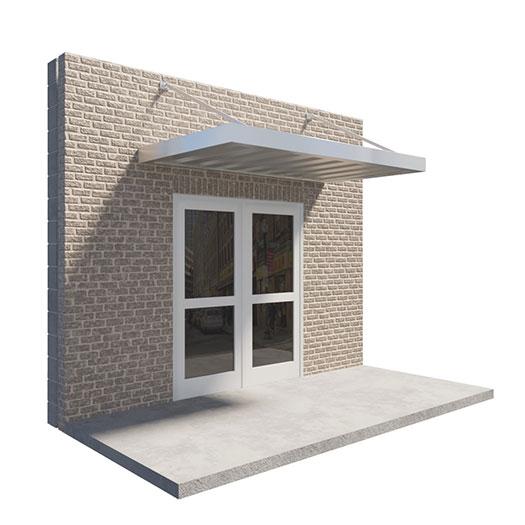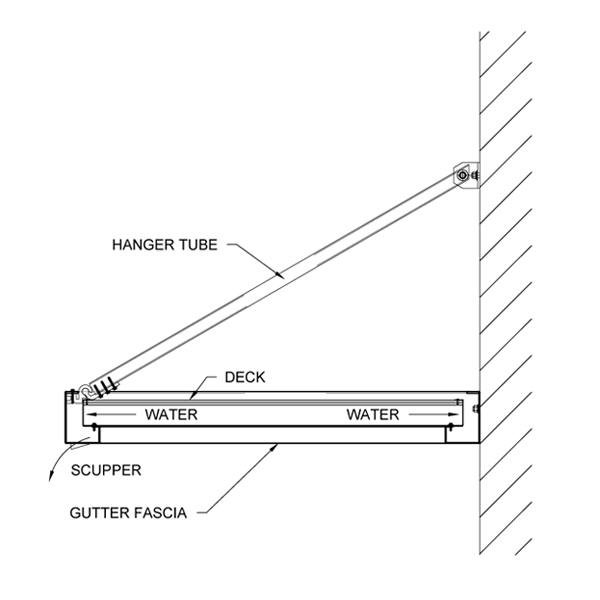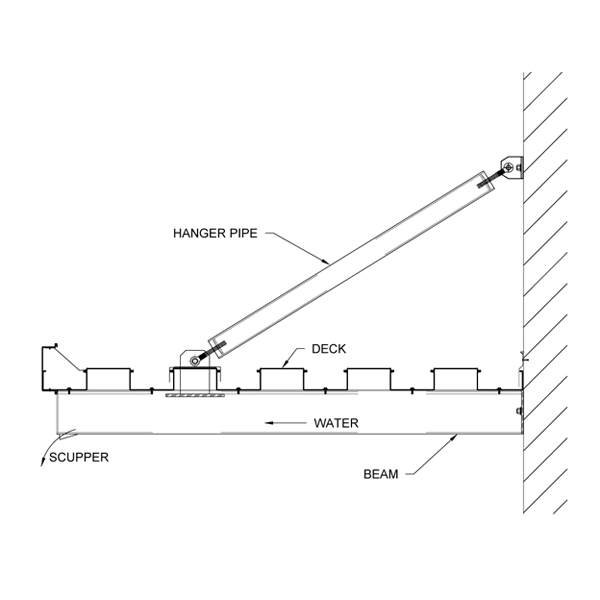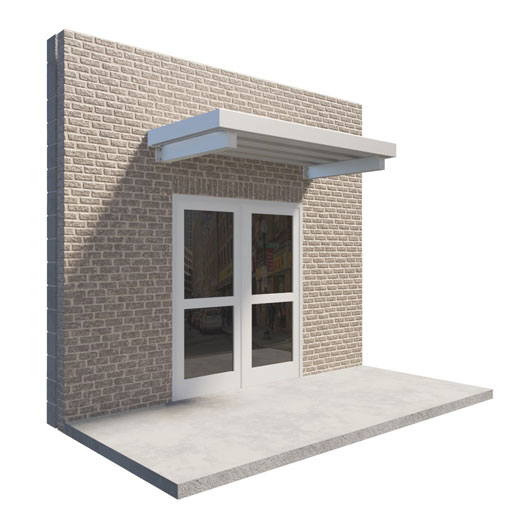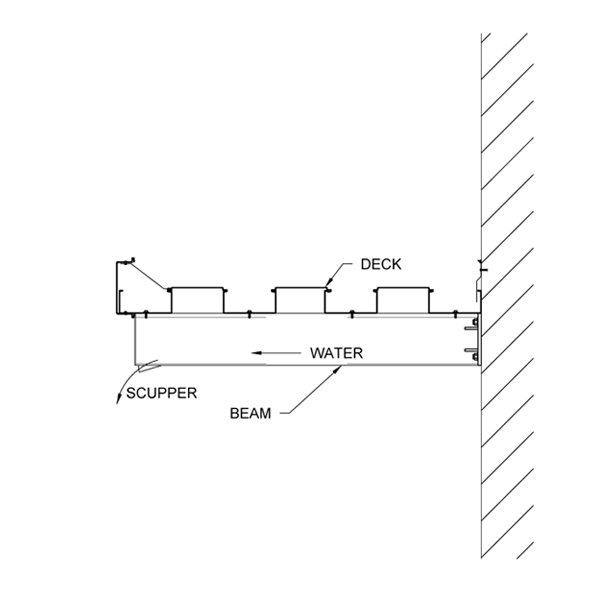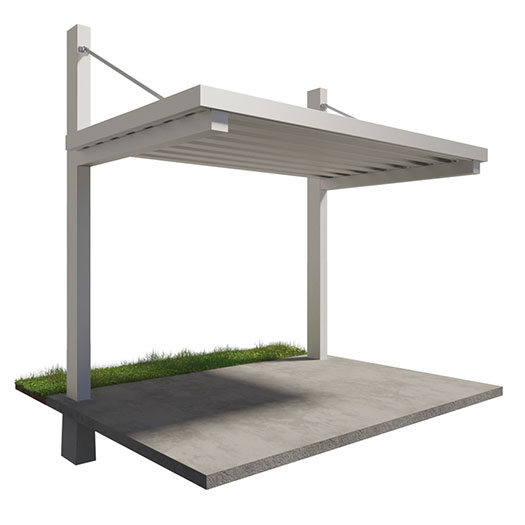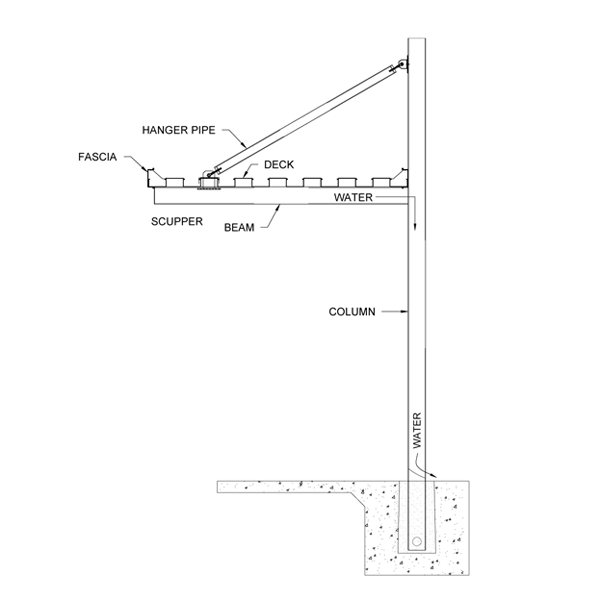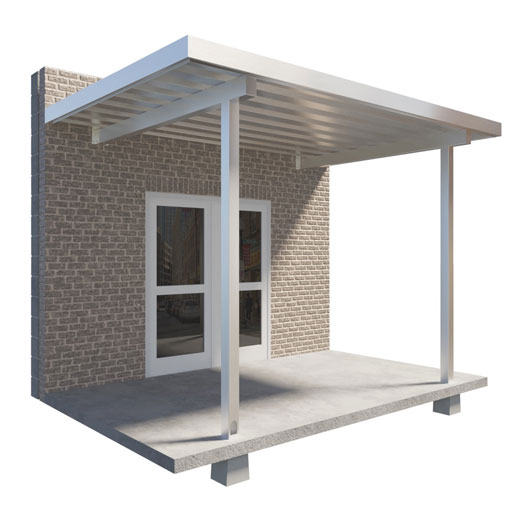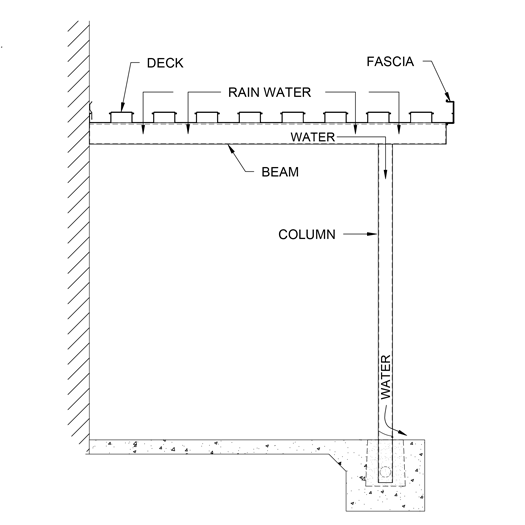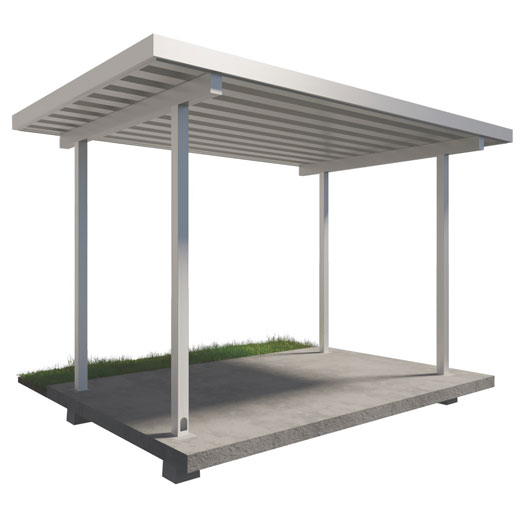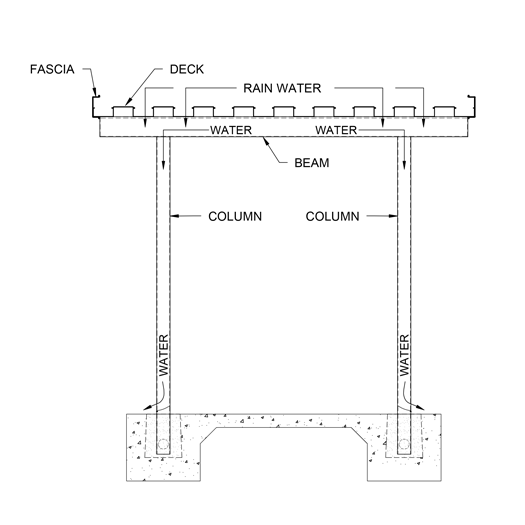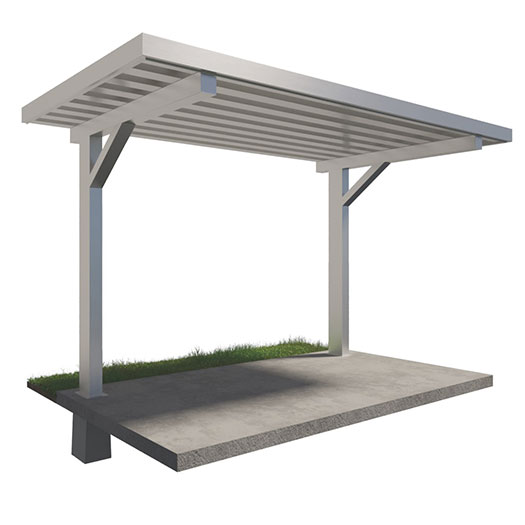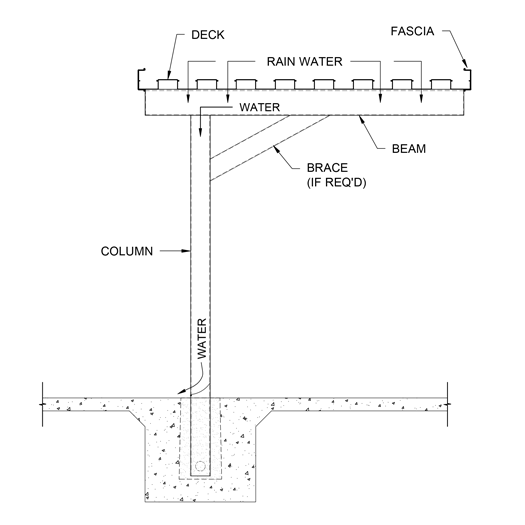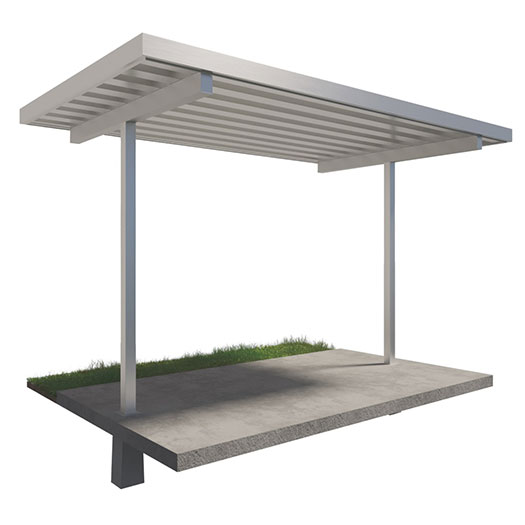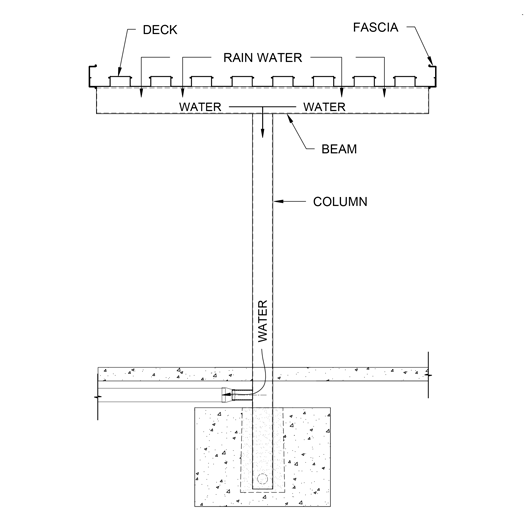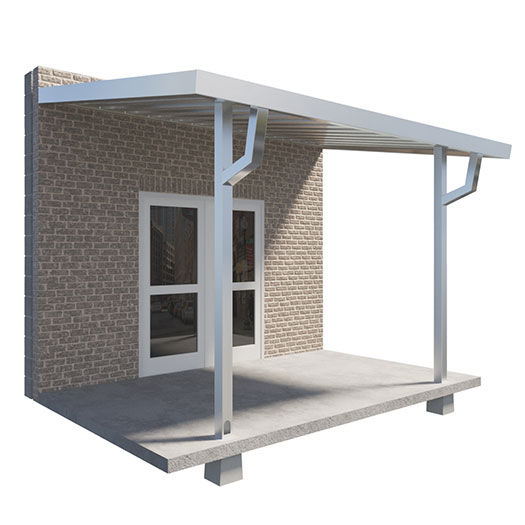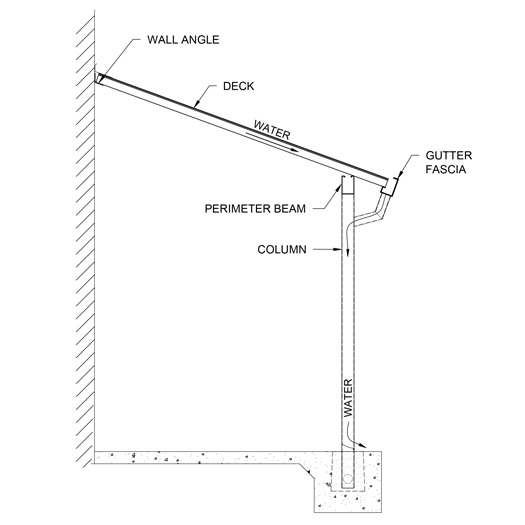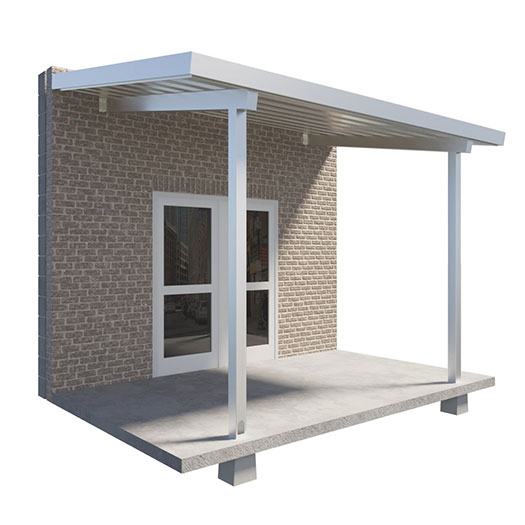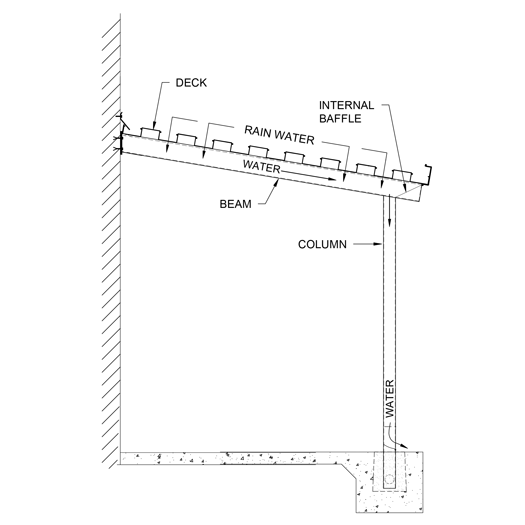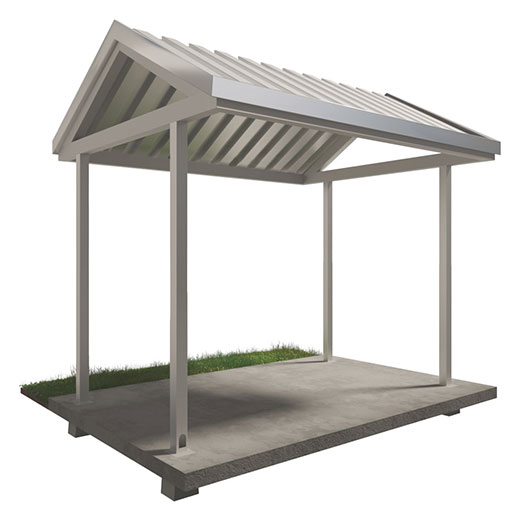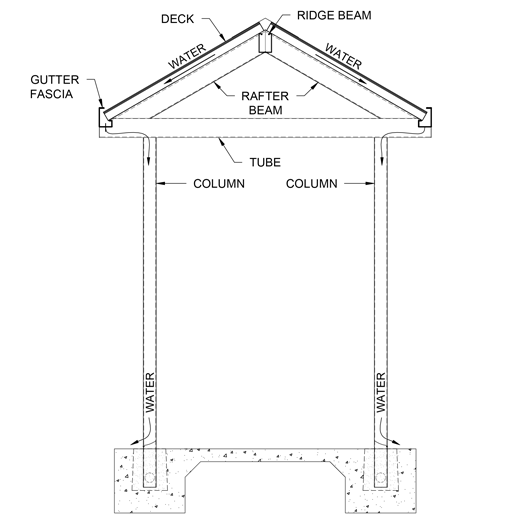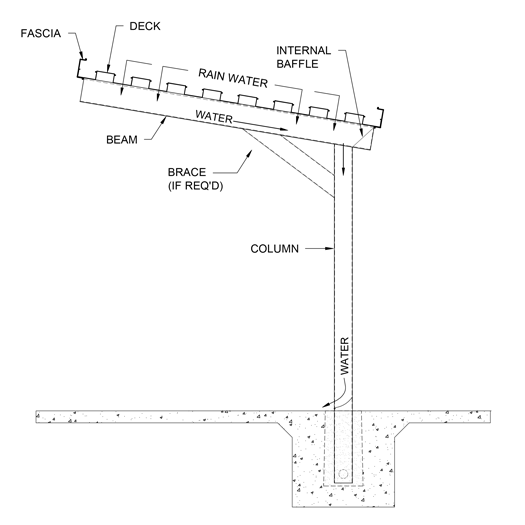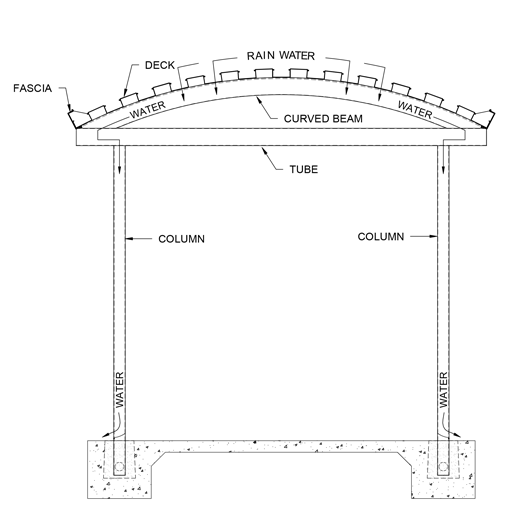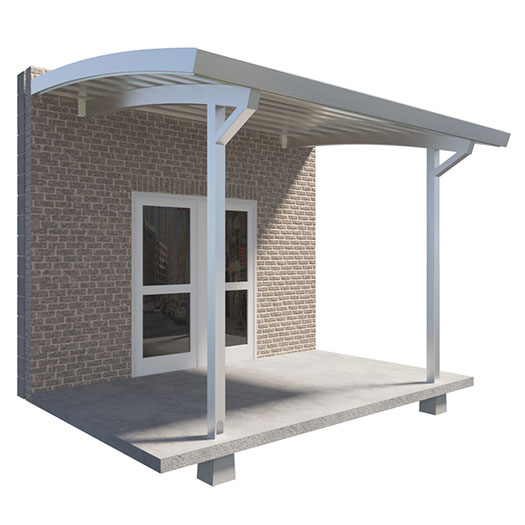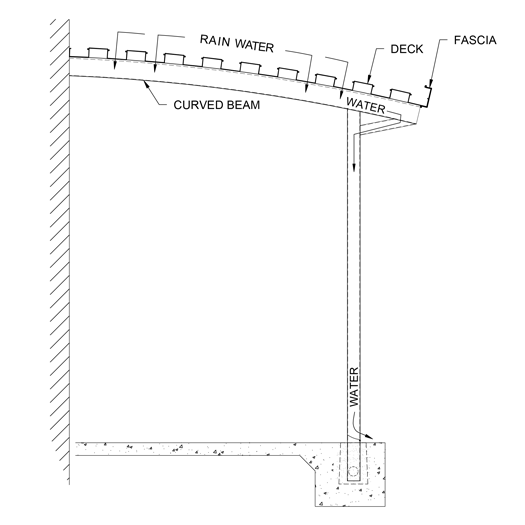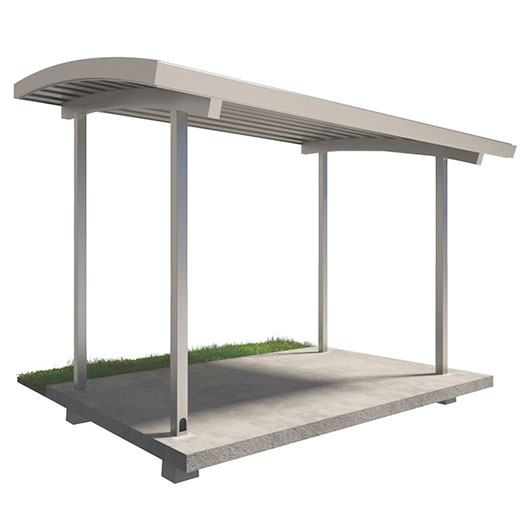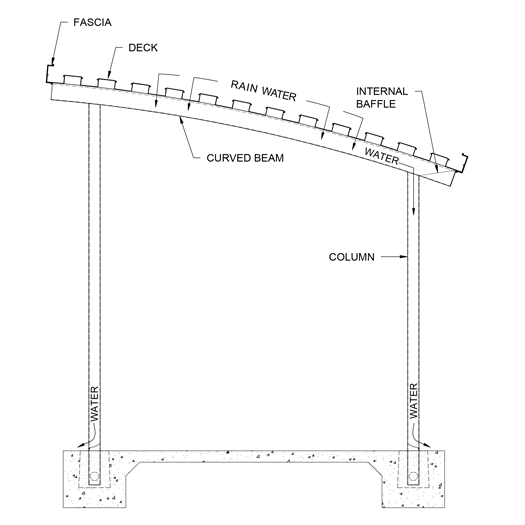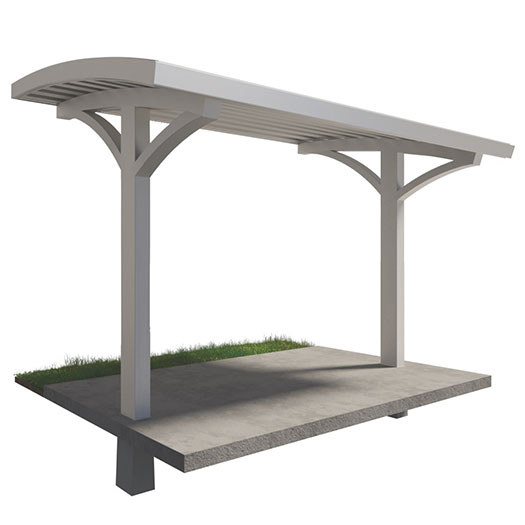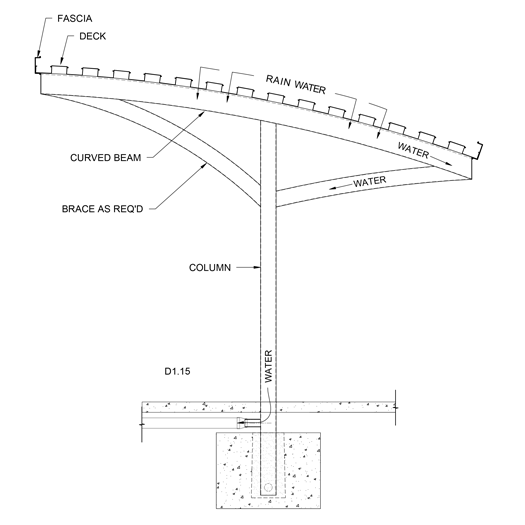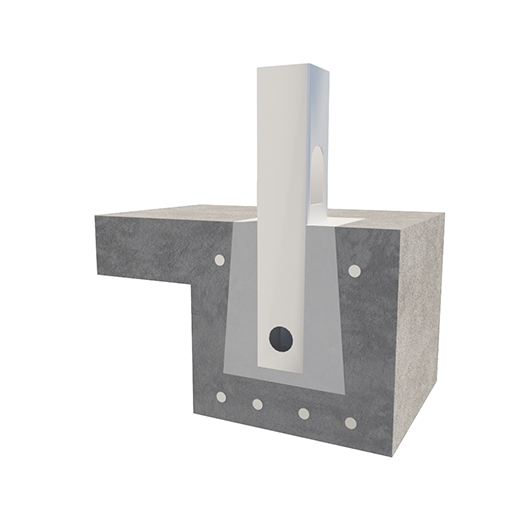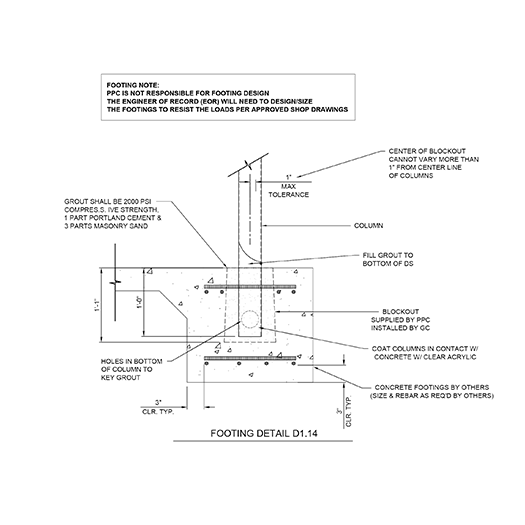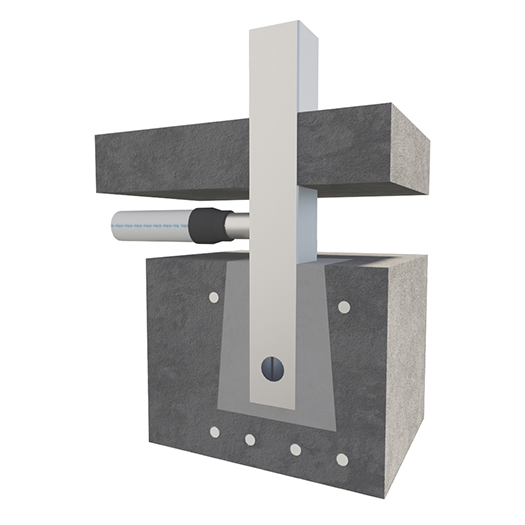Quicklinks
Our design engineering capabilities and our attention to quality installations have helped to position us as the premier provider of both functional walkway covers and architecturally appealing one-of-a-kind canopy systems. From our multi-acre production and material storage facility located just outside of Atlanta, Georgia, we are able to service a full spectrum of projects, ranging from large and complex to small and simple. At Peachtree Protective Covers (PPC) we take pride in being responsive to our customer’s needs. To ensure that project schedules are met, we employ our own team of factory trained installers and dedicated PPC material carriers.
Suspended Canopy
Standard Hanger Canopy
Deck is set in a welded full-perimeter frame constructed from gutter fascia. Water is carried by deck into the gutter fascia frame and then discharged thru a scupper in the corner of the frame at the leading edge of the canopy or into a downspout attached in the corner of the frame at the building.
Custom Suspended Canopy
A beam and diagonal strut is used to support the deck. Water is carried by deck into beams and is discharged thru a scupper at the leading edge or end f the beam or thru a downspout at building. Fascia is used as trim to hide the deck on up to three sides of the canopy and surface mounted flashing is used on the building side of the canopy for water tightness.
Custom Cantilevered Canopy
A “cantilevered” beam used to support the deck. Water is carried by deck into beams and is discharged thru a scupper at the leading edge or end f the beam or thru a downspout at building. Fascia is used as trim to hide the deck on up to three sides of the canopy and surface mounted flashing is used on the building side of the canopy for water tightness.
Column Supported Custom Suspended Canopy
A beam and diagonal strut cantilevered from a column is used to support the deck. Water is carried by deck into beams and from the beam to the columns to be discharged on to grade or into the underground site drain system. Fascia is used as trim to hide the deck on all sides of the canopy.
Flat
L-Bent
A single column is used in combination with the building as structure to support a beam to which the canopy deck is attached. Water is to be discharged from the column on to grade or into the underground site drain system. Fascia is used as trim to hide the deck on up to three side of the walkway cover and surface mounted flashing is used on the building side of the walkway cover for water tightness.
U-Bent
Two columns supporting a beam to which the canopy deck is attached. Water can be discharged from either or both of the columns on to grade or into the underground site drain system. Fascia is used as trim to “hide” the deck on all sides of the walkway cover.
Cantilevered Bent
A single column is used in combination with a “brace” if required to support a cantilevered beam to which the canopy deck is attached. Water is to be discharged from the column on to grade to the “back side” of the walkway or into the underground site drain system. Fascia is used as trim to hide the deck on all side of the walkway cover.
T-Bent
A single column is used to support a beam to which the canopy deck is attached. Water is to be discharged from the column into the underground site drain system to avoid water in the walkway. Fascia is used as trim to hide the deck on all sides of the walkway cover.
Sloped
Lean-To-Bent
Deck is supported by a structural “wall angle” at the building and by a beam that runs parallel to the building which is set on columns spaced at regular intervals down the length of the walkway cover. Gutter fascia is used to capture water at the low point of the slope. It is then routed back to the columns so it can be discharged from the column on to grade or into the underground site drain system.
Sloped L-Bent
A single column is used in combination with the building as structure to support a beam to which the canopy deck is attached. Water is carried by deck into beams and then to columns to be discharged on to grade or into the underground site drain system. Fascia is used as trim to hide the deck on up to three sides of the walkway cover and surface mounted flashing is used on the building side of the walkway cover for water tightness.
Gable or Ridge Bent
Deck is supported by an “a-frame”, ridge beams and gutter fascia. The “a-frame” is supported by columns. The gutter fascia is used to capture water at the low points of the slope. It is then routed through beams to either one or both columns so it can be discharged from the column on to grade or into the underground site drain system.
Sloped Cantilevered Bent
A single column is used to support a beam to which the canopy deck is attached. Water is carried by deck into beams and then to columns to be discharged on to grade or into the underground site drain system. Fascia is used as trim to hide the deck on all sides of the walkway cover.
Barrel
Barrel Vault U-Bent
Deck is supported by a curved and chord beam frame which set on columns. Water is carried by deck into the curved beams and then routed to either one or both of the columns through the chord beam to be discharged on to grade or into the underground site drain system. Fascia is used as trim to hide the deck on all sides of the walkway cover.
Curved L-Bent
A single column is used in combination with the building as structure to support a curved beam to which the canopy deck is attached. Water is carried by deck into beams, falls to the low point of the curved beam and then is routed back to the columns through tubes to be discharged on to grade or into the underground site drain system. Fascia is used as trim to hide the deck on up to three sides of the walkway cover and surface mounted flashing is used on the building side of the walkway cover for water tightness.
Sloped Barrel Vault U-Bent
Deck is supported by a curved and chord beam frame which set on columns. Water is carried by deck into the curved beams and then routed to the columns through the chord beam to be discharged on to grade or into the underground site drain system. Fascia is used as trim to hide the deck on all sides of the walkway cover.
Curved T-Bent
A single column is used to support a curved beam to which the canopy deck is attached. Water is carried by deck into beams, falls to the low point of the curved beam and then is routed back to the columns through tube struts/kickers to be discharged on to grade or into the underground site drain system. Fascia is used as trim to hide the deck on all sides of the walkway cover.
Components
Deck
Extruded Deck 300 Series
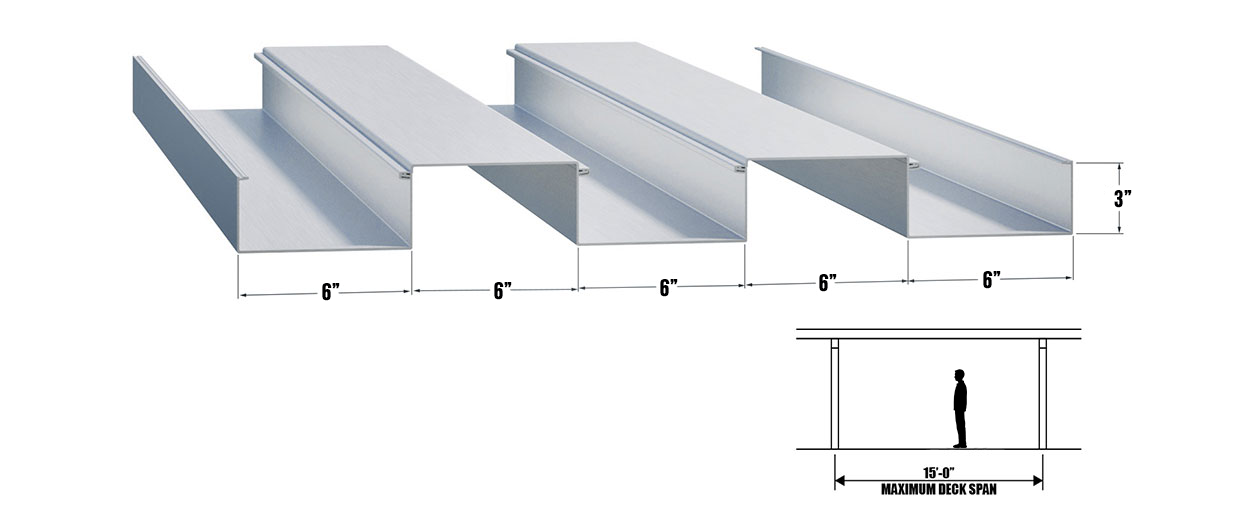
Extruded Deck 400 Series
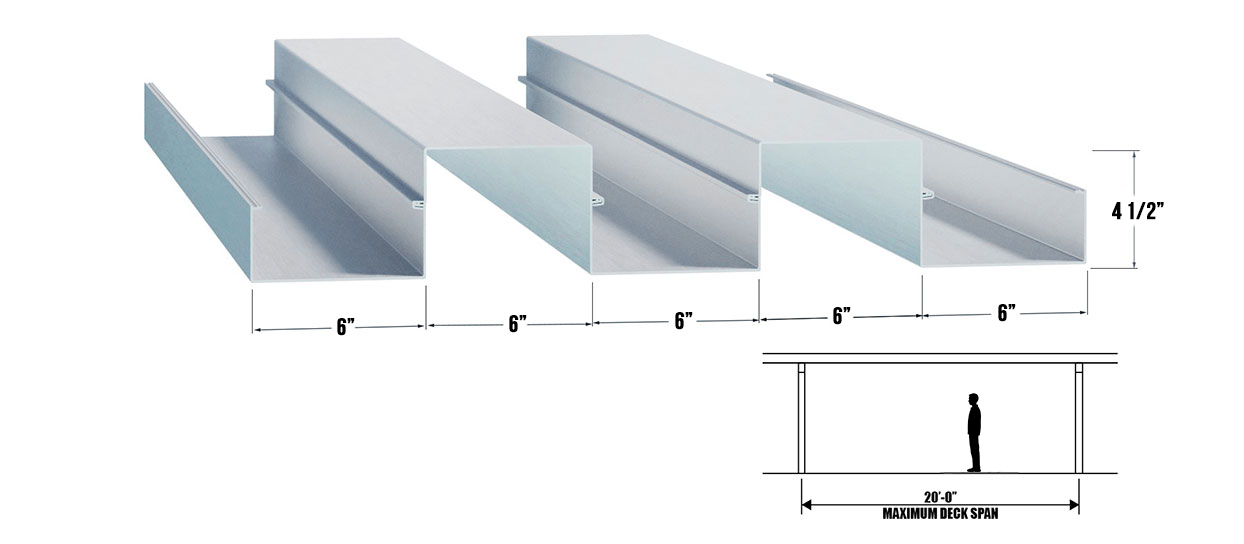
Extruded Deck 600 Series
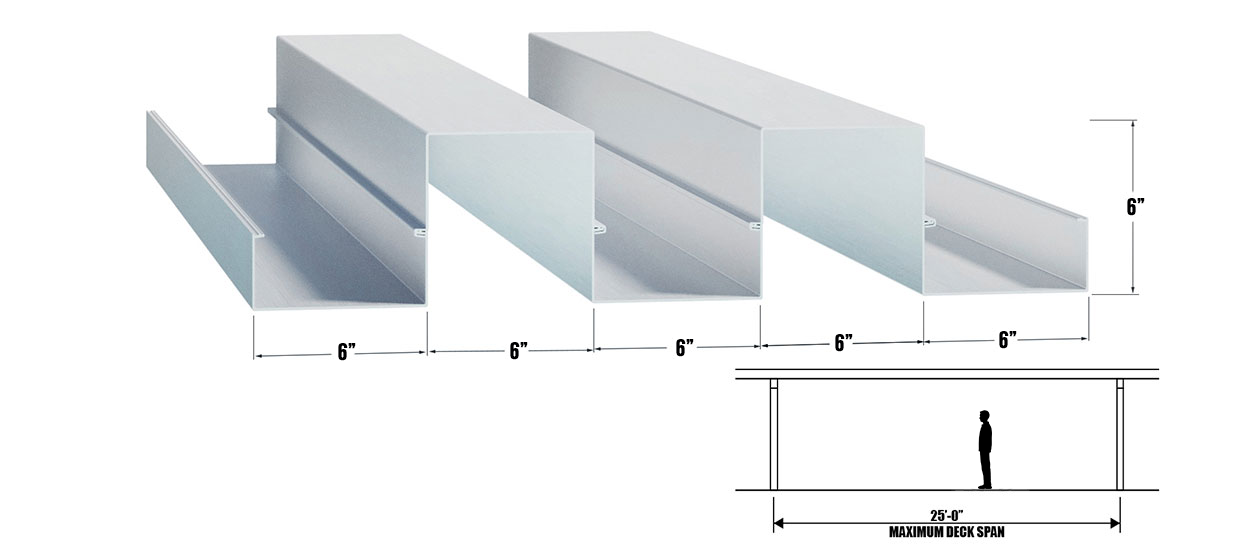
Extruded Deck FS6 Series
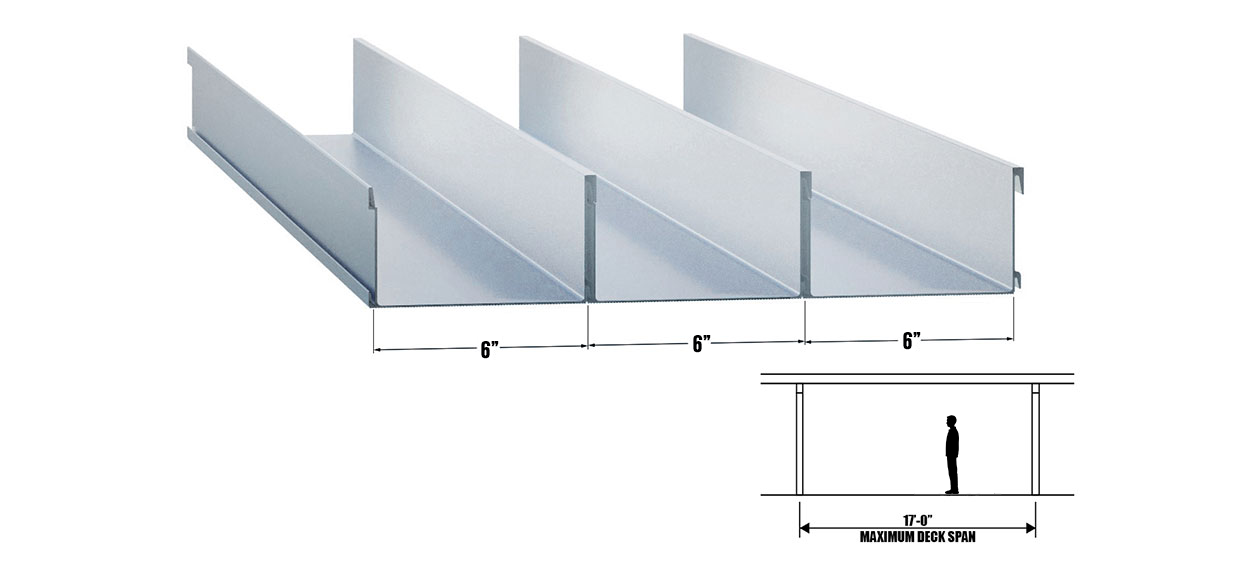
Roll Form Deck
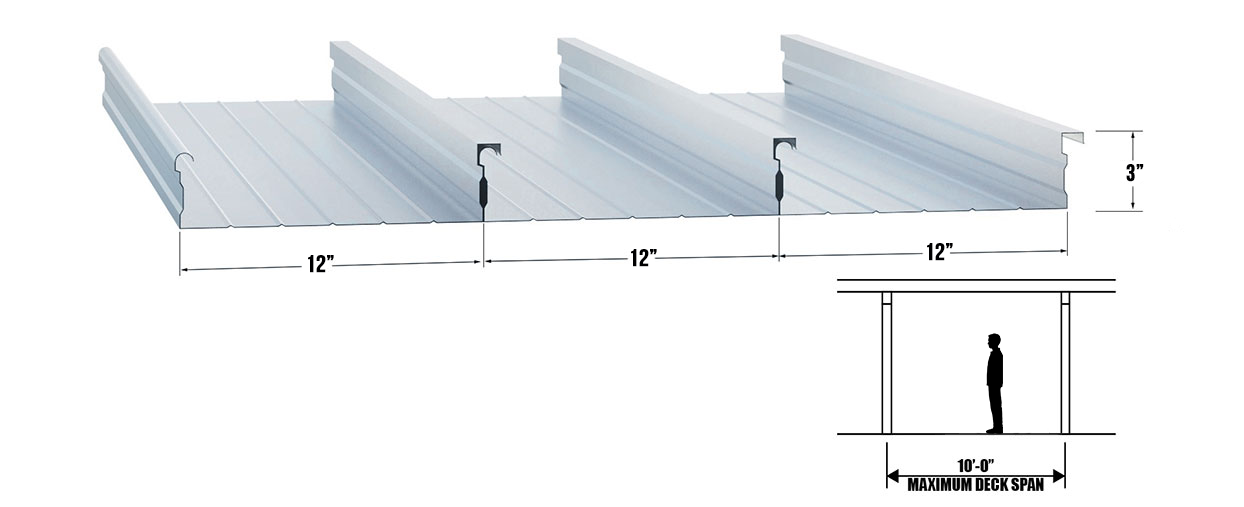
Beams

Columns

Fascia
False Fascia

Gutter Fascia
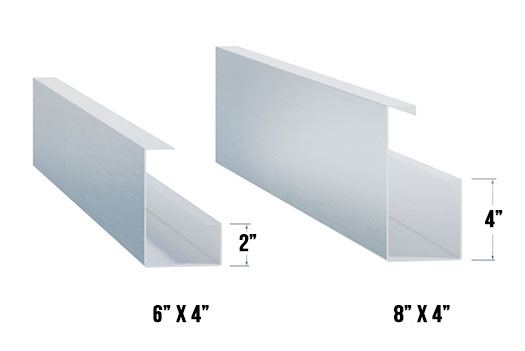
Footing
Typical
Underground Downspout
Specifications
Section 10 73 00 – Aluminum Walkway Covers – View Specifications
Section 10 73 01 – Aluminum Wall Hung Canopy – View Specifications
Finishes
Standard Anodize Colors
 |
Technical Description
Class 2, Clear Anodic Finish – AA-M12C22A31 (Mechanical Finish: nonspecular as fabricated; Chemical Finish: etched, medium matte, clear coating 0.4 mils to 0.7 mils thick), complying with AAMA 611.
Class 1, Clear Anodic Finish – AA-M12C22A41 (Mechanical Finish: nonspecular as fabricated; Chemical Finish: etched, medium matted, clear coating 0.7 mils or thicker), complying with AAMA 611.
Class 1, Color Anodic Finish – AA-M12C22A42/A44 (Mechanical Finish: nonspecular as fabricated; Chemical Finish: etched, medium matte, integrally colored or electrolytically deposited color coating 0.7 mils or thicker), complying with AAMA 611.
Warranty
One (1) year for Class 2, Clear Anodize
Five (5) year for Class 1, Clear & Dark Bronze Anodize
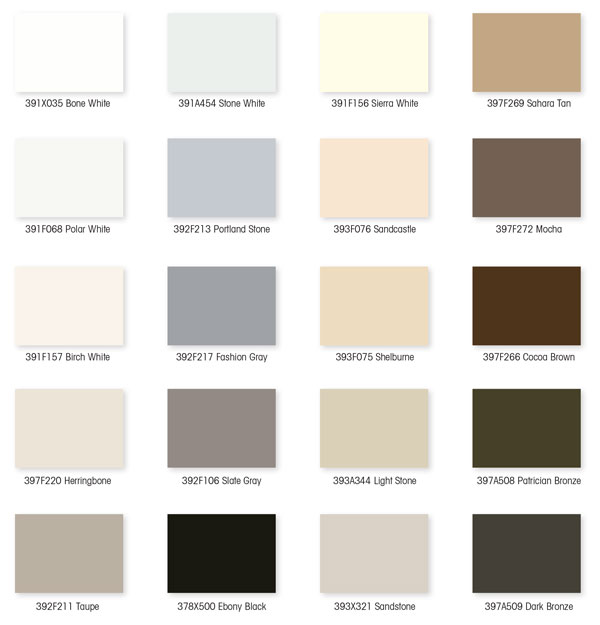
Non-Standard or Custom Colors
Available at a premium relative to the cost of standard colors.
Technical Description
High performance Organic Coating Finish: AA-C12C42R1x (Chemical Finish: cleaned with inhibited chemicals; Chemical Finish: acid-chromate-fluoride-phosphate conversion coating; Organic Coating: as specified below). Prepare, pretreat, and apply coating to exposed metal surfaces to comply with coating and resin manufacturer’s written instructions.
Fluoropolymer Two-Coat Coating System – thermocured system consisting of specially formulated inhibitive primer and fluoropolymer color topcoat containing not less than 70 percent polyvinylidene fluoride resin by weight; complying with AAMA 2604.
Fluoropolymer Three-Coat Coating System – thermocured system consisting of specially formulated inhibitive primer, fluoropolymer color coat, and clear fluoropolymer topcoat, with both color coat and clear topcoat containing not less than 70 percent polyvinylidene fluoride resin by weight; complying with AAMA 2605.
Warranty
Five (5) year for Two-Coat System
Ten (10) year for Three-Coat System
Twenty (20) year for Three-Coat System (if specified)
Baked Enamel Standard Colors
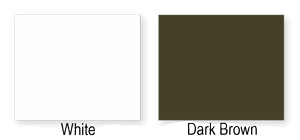 |
Non-Standard or Custom Colors
Available at a premium relative to the cost of standard colors.
Technical Description
AA-C12C42R1x (Chemical Finish: cleaned with inhibited chemicals; Chemical Finish: acid-chromate-fluoride-phosphate conversion coating; Organic Coating: Thermosetting, modified-acrylic enamel primer/topcoat system, except with a minimum dry film thickness of 1.5 mils (0.04 mm), medium gloss), complying with AAMA 2603. Apply baked enamel complying with paint manufacturer’s specifications for cleaning, conversion coating, and painting.
Warranty
One (1) year
Many factors influence the cost and usefulness of a walkway cover. Following the process outlined below will help to ensure an efficient system.
CHOOSE THE LIGHTEST AVAILABLE DECK SECTION
Deck accounts for roughly 60%-70% of the cost of materials in a typical extruded aluminum walkway cover. To minimize cost, always choose the lightest available deck section for the given loading conditions. If no minimum bent spacing requirements exists, choose 3″ deck. For detailed information on deck selection please contact us directly.
SPACE BENTS AT THE MAXIMUM ALLOWABLE INTERVAL
After making the deck selection, set bent spacing equal to maximum allowable deck span. This allows full usage of the chosen deck section.
SET DECK WIDTH TO X’-6″
6″ Deck sections are more economical per square foot than other sections. Setting deck width to X’-6″ reduces material and labor costs.
SELECT THE MOST ECONOMICAL BENT STYLE AND SIZE
To achieve the least costly configuration always choose the smallest columns and beams.
MAINTAIN MINIMUM WIDTH/HEIGHT RATIO = 1.0
Tall, narrow walkway covers offer little protection from the elements. PPC recommends that the height of the walkway cover not exceed the width.
RUN DECK PARALLEL TO WALKWAY
The parallel layout will accomplish three things:
- Allow the use of rigid bents
- Fully utilize the long-span capability of deck
- Eliminate the need for expensive perimeter gutters.
CHOOSE APPROPRIATE FINISH
Selection of finish greatly affects the installed cost of the walkway cover. The painted Baked Enamel finishes in standard white or dark brown are the least costly. Clear Anodize and Dark Bronze Anodize finishes are the medium grade finishes. Finishes using fluoropolymer resin based paints such as Kynar, Hylar and Duranar are high end finishes which come in a wide array of colors. These premium finishes are the most costly available for walkway cover systems and the relates costs can vary greatly depending on the color selected.
INSIST ON AN ENGINEERED SYSTEM
The walkway cover must be designed to withstand all appropriate loads without failure in stress or deflection. Structural calculations, signed and sealed by a registered Professional Engineer are an essential part of a quality walkway cover.
ASK FOR ASSISTANCE
PPC is ready to provide expert guidance at any stage of the planning process. Call us direct at (800) 341-3325 or email us.
Many factors influence the cost and usefulness of a hanger canopy system. Following the process outlined below will help to ensure an efficient system.
DETERMINE THE APPROPRIATE APPLICATION
- Standard Hanger Canopy: consist of gutter fascia framework with the deck running perpendicular to the building. This application is most useful over exterior entry ways.
- Custom Suspended Hanger Canopy: consist of support beams mechanically fastened perpendicular to the building and the deck running parallel with the building. This application has a standard fascia profile in lieu of a gutter type system and is most useful for large projections off the face of a structure and/or extensive lengths of covered area.
SELECTING THE SIZE
After selecting the appropriate application, determine the size of the canopy sufficient for your project.
For exterior entry ways, we suggest and overall width of +6” to the greater on either side of the opening. Determining canopy projection is a matter of preference, however 4’-0” is a common industry standard.
For custom suspended canopies, we suggest that the canopy projection not exceed 10’-0” as a column supported unit is more efficient from a cost and engineering perspective. Reference Design Guide to Extruded Aluminum Canopies.
SELECTING GUTTER FASCIA
Gutter fascia is an extrusion whose purpose is exactly what the description implies. The exterior face of the extrusion is either 6” or 8” inches in height and acts as a fascia for the canopy unit. The interior portion of the extrusion has a “G” shaped profile with flanges that allow for the connections of the decking and hanger supports while also acting as a water trough. Reference section entitled ? for more information.
SELECTING HANGER SUPPORTS AND SPACING
Hanger supports, or tie-backs, mechanically fasten to the support frame of the canopy and extend vertically, typically at a 30 to 45 degree angle back to the building structure. These supports can be square or circular in nature and come in a variety of sizes. Sizing and spacing is determined based upon the overall dimensions and projection of each unit.
SELECTING THE DECK
Decking can be divided into three categories; roll form decking, corrugated decking, and flat soffit decking. Options are dependent upon finish selection and aesthetic preferences. Reference section entitled Deck for more information.
SELECTING DRAINAGE OPTIONS
Both canopy profiles offer internal drainage systems in which the water can be routed to the front of the canopy and be discharged through a scupper or directed to the back or wall side of the canopy and be discharged at grade level or connect to the storm drain via one or more designated downspouts.
CHOOSE APPROPRIATE FINISH
Selection of finish greatly affects the installed cost of each hanger canopy unit. The painted Baked Enamel finishes in standard white or dark brown are the least costly. The roll form decking is only available in the Baked Enamel finish. Clear Anodize and Dark Bronze Anodize finishes are the medium grade finishes. Finishes using fluoropolymer resin based paints such as Kynar, Hylar and Duranar are high end finishes which come in a wide array of colors. These premium finishes are the most costly available for hanger canopy systems and the related costs can vary greatly depending on the color selected.
INSIST ON AN ENGINEERED SYSTEM
The walkway cover must be designed to withstand all appropriate loads without failure in stress or deflection. Structural calculations, signed and sealed by a registered Professional Engineer are an essential part of a quality walkway cover.
ASK FOR ASSISTANCE
PPC is ready to provide expert guidance at any stage of the planning process. Call us direct at (800) 341-3325 or email us.



